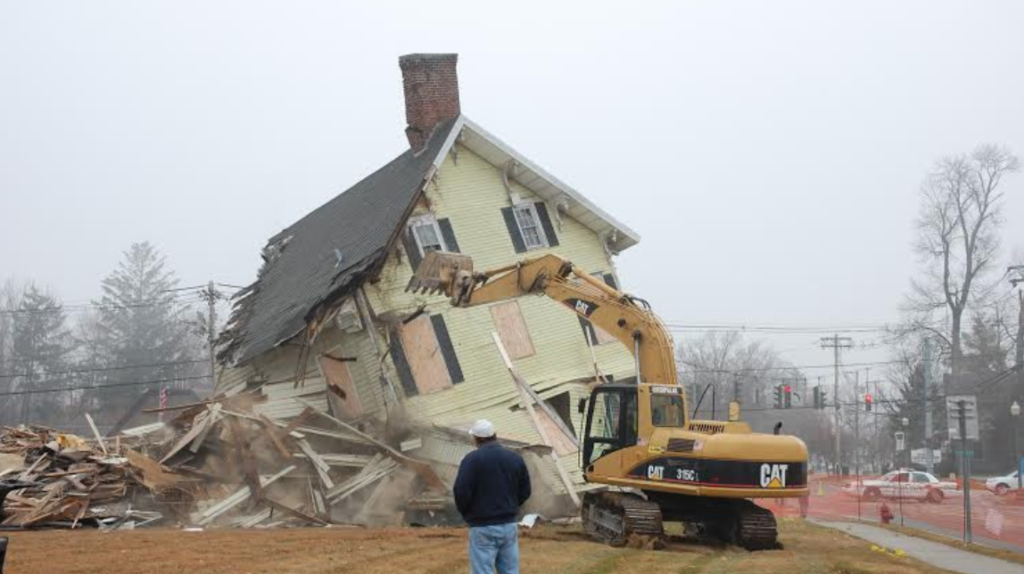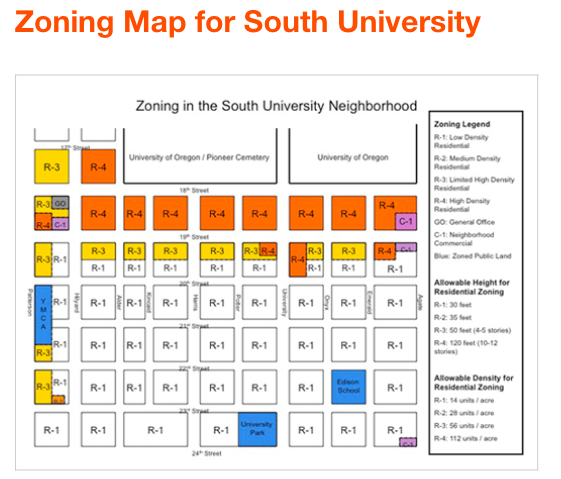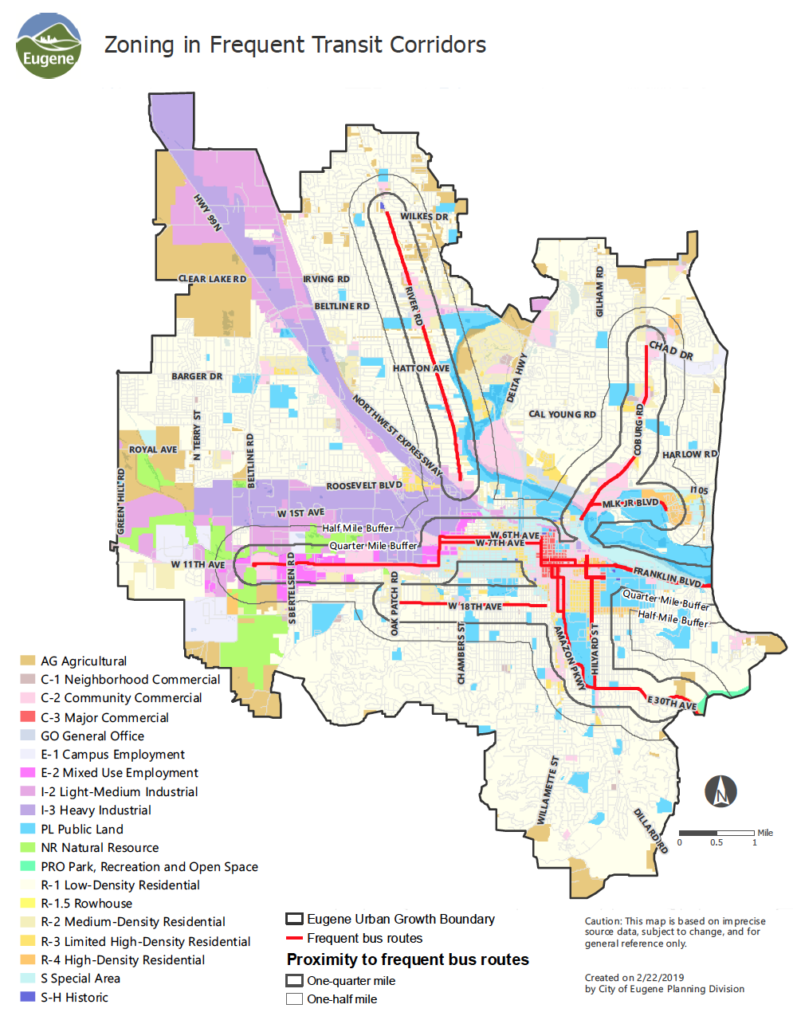
PLEASE READ AND SHARE
Neighbors and friends:
There are several bills being considered by the state legislature that, if passed as written, will have great impacts on both our neighborhood and low-density residential neighborhoods across the city. They have not come out of the blue. Portland is far ahead of us on the path to eliminating all their low-density neighborhoods. But that’s another story ….
We are very concerned that the multi-faceted efforts to upzone (thereby eliminating) low density neighborhoods (like 3/4 of SUN) have stayed well below the radar. Most residents are absolutely unaware of what is coming which is what has prompted us to put together this write-up.
We urge you to take a good look at the info below about current state level legislation. Ongoing lobbying efforts aimed at the same end results have been directed at the Eugene City Council for the last several years. These groups are well organized, well connected and very influential. Even if the legislation coming from Salem was to disappear, we would be faced with the same issues here in Eugene.
Please note: it is likely that everyone who reads this and everyone you talk to about these changes will not have the same reactions, but we all need to understand what’s going on if we want to contribute to the conversation! It is also very clear that different pieces of legislation will impact (negatively or positively depending on your point of view) different neighborhoods in vastly different ways.
and one more thing…. An important first lesson:
Eugene’s four residential zones are defined by density levels – measured by the number of units per acre – and every single house (regardless of size) and every single apartment are each considered to be one unit. For low density residential areas, the maximumallowed density is 14 units per acre. A simple bit of math shows that one unit requires at least 3050 sq ft of property to not exceed the maximum allowable density or a 6100 sq ft lot in order to have 2 units (such as a house and an accessory or secondary unit).
Therefore, allowing more units and/or shrinking the required lot size results in density beyond the current maximum……. or, in other words, upzoning or the elimination of low-density neighborhoods as we know them today. All the bills below will do exactly this.
Senate Bill 1051 (SB 1051)
This bill requires that Eugene allow in areas zoned for detached single-family dwellings at least one accessory dwelling unit (ADU) for each detached single-family dwelling, subject to reasonable local regulations relating to siting and design.
Prior to July 2018 Eugene allowed ADUs in all areas zoned low density residential (R1). As of July 1, 2018 Eugene, changed its code to allow ADUs in all zones where single-family homes were permitted.
However, the City carried forward the regulations used in the R1 zone to the other zones. This led to an appeal by the Home Builder’s Association, which was later remanded to the City for review.
The City has reviewed the ADU regulations and is in the process of writing a new ordinance to comply with SB 1051. A public hearing is tentatively scheduled for May 20, 2019at 7:30 pm.The Council is scheduled to review the new ordinance in work sessions June 10 and 24, 2019. Here are some key points that came out of the Council’s review of the remanded ordinance. (See SB 1051 Summary)
- Owner occupancy* will be dropped from the new ordinance. It is unclear if this will just apply to the new zones where ADUs will be allowed or also to the R1 zone.
- Dropping owner occupancy will motivate absentee and out of area investors who want to rent both the single-family house and the ADU. Potential uses (especially in areas near the University) will be:
- Student rentals
- Airbnb’s
- Dropping owner occupancy will motivate absentee and out of area investors who want to rent both the single-family house and the ADU. Potential uses (especially in areas near the University) will be:
- Minimum lot size and maximum density will remain in the ordinance (but would be affected by House Bill 2001 (HB 2001)).
- Parking requirements will remain in the ordinance but may be eliminated as part of HB 2001.
Written testimony is always best so become familiar with SB 1051 and its implications and write the Mayor and City Council with your concerns. (See link at the end of this summary)
House Bill 2001 (HB 2001)
HB 2001 mandates that Eugene must allow, in areas zoned for detached single-family dwellings, the development of at least one middle housing type on each lot, subject to reasonable local regulations related to siting and design (these terms are left ambiguous and will certainly be argued about!). “Middle housing” means duplexes, triplexes, quadplexes (i.e. small apartment buildings), and cottage clusters. Recently the bill was amended to include townhouses as middle housing.
Often these “middle housing” types are labeled “Missing Middle Housing”. They are not missing. The phrase “Missing Middle Housing” was coined by Daniel Parolek:
“To propel the movement [to upzone single-family zones], he recommends using the term “missing middle housing,” rather than terms such as “upzoning,” “density” and “multifamily,” which he says have a negative connotation.
“I can’t imagine a single neighborhood in the country where people will get excited about the term ‘density,’ ” Parolek said. “Even things like ‘multifamily’ can be a scary term that’s past its life span.” *
HB 2001 will upzone or eliminate the community’s low-density residential R1 zone, unless the residence is protected by Conditions, Covenants and Restrictions (CC&Rs). Older areas will be the most vulnerable. A provision in the bill would eliminate owner occupancy and parking requirements for ADUs. (HB 2001 summary).
*From: The Washington Post, Downsizing the American Dream: The new trend toward ‘missing middle housing, By Haisten Willis, February 14, 2019
Senate Bill 10 (SB 10)
SB 10 will raise the maximum density allowed within a quarter mile of a priority transportation corridor to 50 dwelling units per acre and to 25 dwelling units per acre within a half mile. This effectively changes all land within a mile of priority transportation corridors to R3 (limited high density) and R2 (medium density) respectively. These maximums will allow medium to large apartments and the densities can be set higher. Parking requirements within these areas may also be eliminated.
Mayor Vinis, submitted testimony opposing SB 10. She included a map with her testimony that illustrates the impact of SB 10 on Eugene. (See link for letter. Map additionally attached at bottom of this post).
This mandate will make it difficult to propose changes or new transit routes without receiving push back from neighbors concerned about up zoning their neighborhoods.
House Bill 2003 (HB 2003)
On the surface HB 2003 appears to be asking communities to collect data on housing that can be used to make decisions. On closer reading it contains some problems as noted by Eben Fodor.
“While it is true that cities could do a better job of analyzing housing needs, this seems to have a hidden developer agenda in Section 4 by forcing the cities’ hands toward density increases, regulation removal, and subsidies.”
SECTION 4.
(1) Within 12 months of determining its estimated housing need under section 3 (2) of this 2019 Act, a metropolitan service district, or a city described in section 3 (1) of this 2019 Act, must adopt a housing strategy. A housing strategy is a list of actions, measures and policies the metropolitan service district or city plans to undertake that are calculated to demonstrably lead to greater residential development of needed housing at rates necessary to meet the estimated housing need.
(2) In establishing and undertaking actions, measures and policies under subsection (1)of this section, the metropolitan service district or city shall ensure that land zoned for needed housing is in locations appropriate for needed housing and is zoned at density ranges that are likely to be achieved by the housing market using the analysis conducted undersection 1 of this 2019 Act. Actions, measures or policies may include:
(a) Increases in the permitted density on existing residential land;
(b) Financial or other incentives for developing needed housing and higher density housing;
(c) Provisions permitting additional density beyond that generally allowed in the zoning district in exchange for amenities and features provided by the developer;
(d) Removal or easing of approval standards or procedures;
(e) Minimum density ranges;
(f) Redevelopment and infill strategies;
(g) Authorization of housing types not previously allowed by the plan or regulations;
(h) Adoption of an average residential density standard;
(i) Rezoning or redesignation of nonresidential land; or
(j) Plans for obtaining or using federal, state and regional subsidies and financing to support needed housing.
“Also, I don’t see that they have defined what “affordable” means. Maybe it’s somewhere else in ORS. This seems to lack a market analysis, which would tell us what people actually want. Developers/Legislators are using a different committee for this bill than for the other housing bills, which is interesting.”
Senate Bill 8 (SB 8)
SB 8 makes it so if someone appeals a land use decision and loses, they are required to pay the other party’s attorney’s fees. This will effectively shut down the ability of residents to question land use decisions. The League of Women Voters of Oregon opposed this bill and said:
“Enforcement of our land use laws is a complaint driven system. All parties must have access to adjudication of those complaints without undue threats of financial harm.”
Summary
The above Bills will significantly impact not only Eugene but all communities in Oregon. Cities will be unable to plan for growth in a way that is appropriate for their community and SB 8 will stifle residents from questioning land use decisions.
If this concerns you go to the Oregon Legislative information System (OLIS) and find out more about these bills. Submit written comments to the committees hearing testimony on the Bills. (see the link to OLIS below)
Important Links
Comments on SB 1051 can be sent to: (copy and paste addresses into your email if your browser does not work with the links provided)
Senator Shemia Fagan sen.shemiagfagan@oregonlegislature.gov;
Senator Dallas Heardssen.dallasheard@oregonlegislature.gov;
Senator Jeff Golden sen.jeffgolden@oregonlegislature.gov;
Senator Tim Knopp sen.timknopp@oregonlegislature.gov;
Senator Lauie Monnes sen.lauriemonnesanderson@oregonlegislature.gov;
Representative Alissa Keny Guyer rep.alissakenyguyer@oregonlegislature.gov;
Representative Tawna Sanchez http://rep.tawnasanchez@oregonlegislature.gov;
Representative Chris Gorsek rep.chrisgorsek@oregonlegislature.gov;
Representative Mark Meek rep.markmeek@oregonlegislature.gov;
Representative Mike Nearman rep.mikenearman@oregonlegislature.gov;
Representative Ron Noble rep.ronnoble@oregonlegislature.gov;
Representative Carla Piluso rep.carlapiluso@oregonlegislature.gov;
Representative Duane Stark rep.duanestark@oregonlegislature.gov
Comments on the other Bills should be sent to the appropriate committee found on OLIS: https://olis.leg.state.or.us/
Contacts
For more information or questions contact both:
Bill Aspegren ahaspegren@comcast.net
and
Carolyn Jacobs carolyn.i.jacobs@gmail.com


SB 10 map of impact to Eugene
